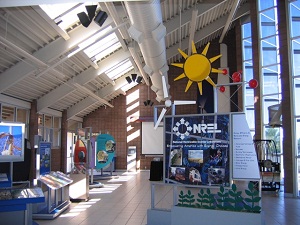A trip to NREL
 Recently I visited the Visitor’s Center at the National Renewable Energy Laboratory (NREL) in Golden, Colorado. It’s the second time I’ve tried to go there—the first was in 2002, but I was told then that the visitor’s center was closed because of national security (the country was still reeling from 9-11). With all those years of anticipation, it was kind of a bummer, actually, to finally see how small the center is and how little of what’s going on at NREL is shown there—just 400 feet from the building, some of the most cutting-edge photovoltaic (PV), wind, biomass and building technologies are being developed and tested.
Recently I visited the Visitor’s Center at the National Renewable Energy Laboratory (NREL) in Golden, Colorado. It’s the second time I’ve tried to go there—the first was in 2002, but I was told then that the visitor’s center was closed because of national security (the country was still reeling from 9-11). With all those years of anticipation, it was kind of a bummer, actually, to finally see how small the center is and how little of what’s going on at NREL is shown there—just 400 feet from the building, some of the most cutting-edge photovoltaic (PV), wind, biomass and building technologies are being developed and tested.
Yet all they have here is a small display hall that covers basic information about renewable energy. Sure, the gizmos were fun: Turn the crank to experience how much more energy is needed to power an incandescent light bulb and its compact fluorescent light counterpart; flip a switch to watch a photovoltaic panel in action; play the quizzes; see the electric dioramas of geothermal energy; and see generations of PV panels, built between 1980 and the early 2000s; see small thin-film PV cells—all these things are great and important learning tools.
But just a few hundred yards away scientists are busy putting PV panels to stress and aging tests to determine how they’ll hold up over time. And they’re getting the next generation of PV ready for the commercial market.
And, thanks to a little video at the visitor’s center, I saw how wind turbine blades are tested, like simulating the effects of high winds on the blade by bending it back and forth by as much as 15 feet. Still, an actual 100 foot long, white fiberglass blade sticking out of a testing facility, wagging up and down like a giant tongue, would have been awesome.
But scientists at NREL are working with private companies and their proprietary technologies, so they can’t open all the doors to the public. And I had to remember this center is only an introduction to renewable energy. As such, it succeeds. People are coming regularly to visit, according to the center’s docent. And even as I was leaving, a family was coming to visit, eager to learn about how their children’s power needs will be met in the future.



